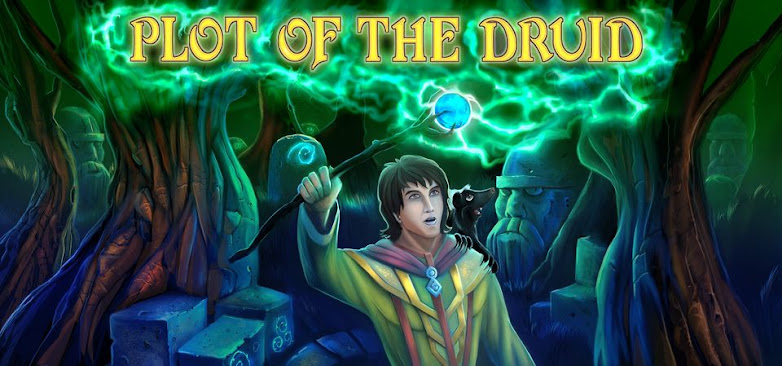And... we launched a FREE demo!
It's Yakir, the project
lead, director, producer, writer, designer and programmer of Plot of the Druid!
(Yes, that's how it goes with being an indie dev... you need to take on many
roles in order to bring a game to life.)
Now that the demo has
been launched, I wanted to take a moment and write about what we’ve been doing
during this fruitful year. It’s been busy.
In my last post, I
mentioned some of the features, areas and characters that we’ve made.
We also added a new feature – a journal to help the player focus on their journey. At first, it was meant to be a hint system and a “to-do” list, but we decided to take a more story-wise approach.
In general, “to-do” lists are collections of short, simple statements about the player's goals. They can certainly help the player keep focus, but IMO they can also pull the player out of the game and reveal a bit too much about the developer’s plans. We want to provide an option to help the player keep their focus, but in a more subtle way.Jase will keep a journal
of his thoughts as the story progresses. The player can read the journal at any
time to get a quick overview of the journey so far. The journal will also help players
who are coming back to the game after a long time. It’s similar to the approach
taken in the Broken Sword games, and it felt like a good method to use here.
Hints and “to-do” items
will be incorporated into the game itself. The player can find them by having
Jase explore and talk to the other characters. This is the “sign-posting golden
rule,” which was first introduced by LucasArts games.
Apart from that, we've completed
around 80% of the first chapter, and it’s appeared in playable form in several
showcases around Israel (my country). I was pleased that it got a lot of
positive feedback as well as many constructive suggestions. Hey, making a game is
a process, not just a result!
My original plan was to have the first chapter be the demo, but it was getting to be a bit too long and I didn't think it would present well if I cut it down. A hard decision was made - we would need to add a short prologue called “Nightwatch” that would serve as the demo. Aaron and I brainstormed many funny ideas until we hit the sweet spot.
I knew that the demo should have at least some of the hooks that will appear in the full game, and I decided that a shapeshifting mechanism might do the trick.
We tried to make puzzles
challenging but still reasonable. We are not ashamed to admit it was super challenging
for us to create such balance. It led me to think that another good feature
would be to have two difficulty levels. The normal mode will be for gamers who
are younger or who have less experience, and it will focus more on the story. The
hard mode will be more experienced gamers who
are looking for a challenge.
In addition, I stuck
with another LucasArts golden rule – allow the player to work on multiple
puzzles at once, so if they get stuck on a puzzle they can always work on a few
other ones.
After everything was
documented, Michel and I started work on a quick visual concept, another fun
process that creates a rough image of your vision. It allows the game’s art to
influence the story and mechanics, gives us more ideas and helps us quickly
spot potential issues.
This is our first concept of the room:
I had been using
Visionaire Studio, a game engine that was a good starting point, but not
flexible enough for my needs. So… another hard choice! ... I switched to the
Unity engine with the Adventure Creator plugin. It gave me just the boost I
needed. Well, at least as a proof of concept.
So, I started the demo
from scratch in Unity, knowing full well that I’d need to migrate all the
contents for Chapter 1 to Unity as well.
To my delight, it took less than a week to integrate the art with the new shapeshifting mechanism. After that came a long process of polishing the art and animating the characters and environments.
While all this was happening, Aaron and I kept developing the character’s backstories, personalities and dialogs. Yay, more fun! (I will explain more about these in a separate post.)
At last, Zevik and I worked on the music and SFX. We decided it would be best to give each supporting character their own background music that would express their personality and general “vibe.” When Jase is exploring, there will be a variety of short “idle tracks” that will play in random order. And for closeups – you guessed it – another set of short tracks that will play in a loop. Hopefully this approach will maintain the mood of the game without the music getting too repetitive.
Each time the player advances the plot and/or completes a mission, the soundtrack will change, creating a sense of accomplishment and success.
Here's two samples of the background music:
Looking back, I think the hard decisions worked out well.
After nine months, the demo was ready for beta. It has about an hour of gameplay along and the flexibility to add new features as we come up with them.
Whew! That was a really long post. I hope you enjoyed it. (Feel free to comment below.)
Next time, I’ll talk more
about the voice acting and localization, as well as the latest updates for the beta.
Stay safe and healthy 😃
Yakir









Comments
Post a Comment